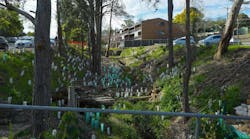
Among the many problems still facing the region around the Fukushima nuclear power plant is what to do with 700 million cubic feet of radioactive soil. For the moment, it’s sitting in abandoned local fields, packed into black plastic bags.
Unfortunately, floods last year washed away some 700 of the bags, and the soil, which contains cesium isotopes, has since been detected in rivers up to 100 miles from where it started.
Among the many problems still facing the region around the Fukushima nuclear power plant is what to do with 700 million cubic feet of radioactive soil. For the moment, it’s sitting in abandoned local fields, packed into black plastic bags.Unfortunately, floods last year washed away some 700 of the bags, and the soil, which contains cesium isotopes, has since been detected in rivers up to 100 miles from where it started. [text_ad] Japan’s government says most of the soil, more than 99% of it, can be recycled. What does that mean, exactly? Scientists have had some success removing cesium from soil using potassium solutions, but it’s not a complete fix for the problem—and as this Washington Postarticle notes, the soil collected so far is enough to fill 8,000 Olympic-size swimming pools. Phytoremediation has also been attempted with plants such as sunflowers and—after the Chernobyl disaster—hemp, but there are limitations to that technique as well.The Post article revisits Fukushima five years after the earthquake and tsunami, reporting on the slow progress that’s being made there. The process of decommissioning the plant is only about 10% completed, officials say, and could take as long as 40 years.Engineers have constructed an “ice wall” below ground surrounding part of the plant in an attempt to stop the movement of groundwater, which has been seeping in and becoming radioactive. The 1,500-foot-long wall of frozen soil encircles four of the reactor buildings and was intended to prevent further water from entering, but officials fear it may still allow leaks. The water that is already contaminated can be treated to remove most, but not all, of the radioactive isotopes. It has been stored in tanks, but those, too, have occasionally leaked into the ocean. As the article reports, about 1,000 tanks now hold 750,000 tons of water, and 300 tons a day are being added. More tanks are being built. The long-term options include further treating the water and releasing it to the ocean, letting it evaporate, or injecting it deep underground.Japan’s government says most of the soil, more than 99% of it, can be recycled. What does that mean, exactly? Scientists have had some success removing cesium from soil using potassium solutions, but it’s not a complete fix for the problem—and as this Washington Post article notes, the soil collected so far is enough to fill 8,000 Olympic-size swimming pools. Phytoremediation has also been attempted with plants such as sunflowers and—after the Chernobyl disaster—hemp, but there are limitations to that technique as well.
The Post article revisits Fukushima five years after the earthquake and tsunami, reporting on the slow progress that’s being made there. The process of decommissioning the plant is only about 10% completed, officials say, and could take as long as 40 years.
Engineers have constructed an “ice wall” below ground surrounding part of the plant in an attempt to stop the movement of groundwater, which has been seeping in and becoming radioactive. The 1,500-foot-long wall of frozen soil encircles four of the reactor buildings and was intended to prevent further water from entering, but officials fear it may still allow leaks.
The water that is already contaminated can be treated to remove most, but not all, of the radioactive isotopes. It has been stored in tanks, but those, too, have occasionally leaked into the ocean. As the article reports, about 1,000 tanks now hold 750,000 tons of water, and 300 tons a day are being added. More tanks are being built. The long-term options include further treating the water and releasing it to the ocean, letting it evaporate, or injecting it deep underground.About the Author
Janice Kaspersen
Janice Kaspersen is the former editor of Erosion Control and Stormwater magazines.


